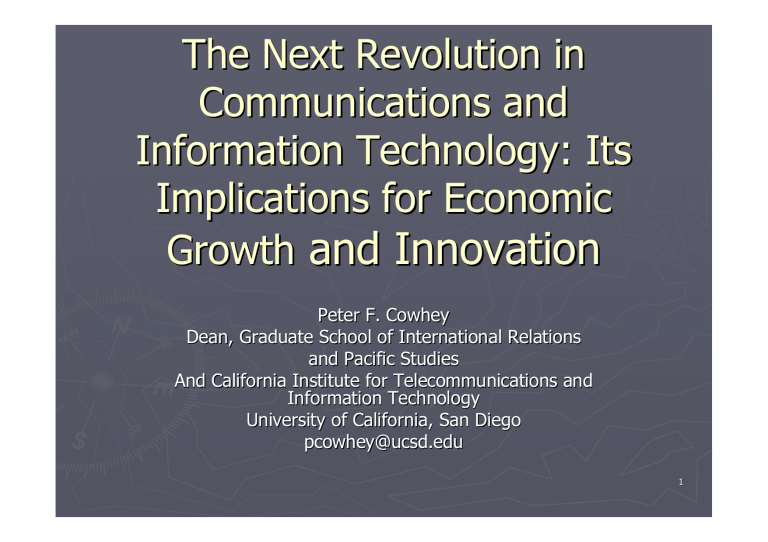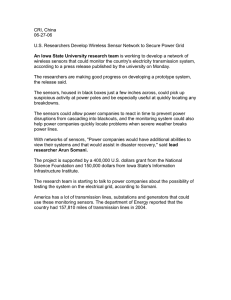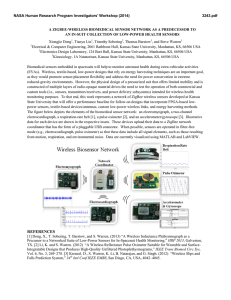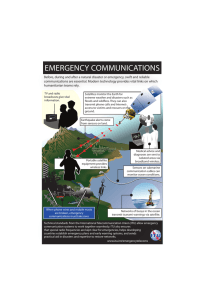and Innovation The Next Revolution in Communications and Information Technology: Its
advertisement

The Next Revolution in Communications and Information Technology: Its Implications for Economic Growth and Innovation Peter F. Cowhey Dean, Graduate School of International Relations and Pacific Studies And California Institute for Telecommunications and Information Technology University of California, San Diego pcowhey@ucsd.edu 1 Information on UC San Diego www.ucsd.edu ► Young! Created in 1959 ► 23,000 students (growing to 30,000): 2nd largest number of undergraduate student applicants in US ► 8 Nobel Prize Winners ► #6 in US in research & development funds ► Top ten in National Research Council PhD training ratings and in membership in National Academies of Science and Engineering ► Major Research Institutes include: California Institute on Telecommunications and Information Technology and San Diego Supercomputer Center 2 Graduate School of International Relations and Pacific Studies (IR/PS): www-irps.ucsd.edu ► ► The only graduate school in US devoted to professional school training focused on Asia and the Americas Masters (2 years) and PhD Training along with mid-career professional training (ICAP) 160 students in entering Masters class from 22 countries Specializations ranging from public policy through environmental policy and international management of firms and non-profits ► Faculty of distinguished political scientists and economists UCSD ranks 2nd in comparative politics, 9th in international relations, and 15th in economics in US ► Unique training: All students take micro-economics, finance, accounting, international politics, public policy analysis, and comparative politics and economics 3 Strong Long-Term Prospects for Communications Networks and Information Technology as Catalysts for Economic Growth ► ► The current market downturn ignores fundamental economic advantages of digital communications and information technology (CIT) in long-term The stakes are high Productivity is the key to long-term growth In mature economies, CIT can raise productivity by 0.25% to 0.50% annually—a huge difference cumulatively. In all countries, “digital sciences” are key to transforming traditional scientific research and its application to social problems 4 A Lesson From Railroad History: Infrastructure Explosions Are Uneven!!! ► Railroads had busts and booms in U.S. Cost and flexibility of the infrastructure will influence severity of the bust and boom problem ► They required complementary innovations to be sustainable—the Standard Oil and Armour Meatpacking Trusts created new uses of Railroads ► They require regulatory and policy decisions to prosper—time zones and Railroads 5 Why communications networks are in a better position than railroads ► Cost ► Technology ► Flexibility of use 6 The Cost of Communications Networks Is Low Cost per Mile of Connectivity Infrastructure Aerial Wireless* $4,433 Wireless Towers $11,083 Copper Cable $22,750 Coaxial Cable $29,250 Optical Fiber $40,625 Gas Electricity Waterway $134,583 $232,604 $300,625 $847,917 Roadway * Experimental network solution $USD per Mile Source: Canadian National Broadband Taskforce and InfoAmericas 7 Fiber Optic and Data Storage Are Moving Faster Than Moore’s Law 8 Network Demand staying high! (Source: Perelman, SAIC) 350 Internet: Internet: (1 (1 Year) Year) # # of of hosts hosts + + 16% 16% data volume+100% data volume+100% metro metro fiber fiber + + 80% 80% Sensors Sensors RFID + RFID + 30% 30% (RFID=Radio (RFID=Radio Frequency Frequency Identification Identification Devices) Devices) 300 250 200 150 100 Total Wireless MOU 50 Long Distance MOU 0 98 99 00 01 02 03E 9 Network technologies change rapidly so need flexible evolutionary path! ► ► Broadband to the Home and Small Businesses requires multitechnology networks with different cost structures & business models depending on demand patterns Need to experiment with best network design! An example: The youth market does not dominate wireless in US (unlike Korea) Most fiber is in biggest “15% of office buildings”: Need to expand high speed access to other businesses and homes 3G = Wide Area Mobile Data Network on licensed bands ► Use for secure high speed mobility at a fixed price AND for remote high speed networking Wi-Fi (or 802.11) = Local Area Fixed Data Networks—primarily on unlicensed bands ► Wi-Fi for campus environments fed by high capacity fiber WiFi won’t replace 3G! 100,000 Wi-Fi hotspots equal coverage area of 3 3G cell sites (100,000 3G cell sites in US by 2006) We need big fiber capacity for some needs, but wireless may be more effective than fiber for many users 10 Complementary technologies for the use of networks ► Growth of remote sensors and radio identification devices ► Growth of new computing systems (e.g., the GRID) 11 Consumers are more sensitive to the total cost of a service than the price per bit! Projected consumer willingness to pay $ per Mbyte 43.90 20.00* 5.30 3.97 Cost of 3G: $.20-.30/MB 1.20 0.15 SMS iMode data Highly- Voice Still pictures compres sed video clip 0.06 0.003 Cost of wireless Movies LAN: (broadcast $.03-.06/MB Telecon- Music ference (MP3(VHS- quality) -quality) quality) * Based on compressed file transmission, estimated willingness to pay Source: GS Research; McKinsey analysis 12 Elements of the Revolution: Wireless and New Computing Models ► Vast Increase in Internet End Points Embedded Processors everywhere in old products ► Your car is a computer and sensors gathering data ► Radio frequency identification devices (RFIDs) New uses – every human body is a data stream ► Emergence of a Distributed (Networked) Planetary Computer Storage of Data Everywhere Scalable Computing Power (the GRID) 13 Selected 3-5 year needs for customers with security needs for RFIDs (Source: SAIC) The Issue ► ► Marco Personal Security 9-11 Lost retail sales Intelligent Sensing Factoids Homeland Security sensor systems Control theft: 22-4% revenue lost, mostly employee In the supply chain, cost reduction est. of 1010-30% inventory, 55-40% labor and sales increase of 11-2% #1 issue in preparing for Iraq for DOD logistics 14 So, Where Are We Today? (Source: SAIC) Adoption Adoption Rate Rate of of New New Technologies Technologies IT/Customer Integration Macro Security 02 Network Systems 20 00 20 98 19 96 19 94 19 92 19 19 90 Intelligent Sensing 4 Critical Technologies on the cusp on moving into the customer innovation cycle All All of of These These Are Are Moving Moving to to Mass Mass Customer Cycles Customer Cycles Macro Macro Security Security Def: Def: Detection, Detection, Authentication, Authentication, and and Authorization Authorization of of people people & & cargo cargo Core Core Science Science –– Biometrics, Biometrics, Invasive Invasive sensors, sensors, recognition recognition software, software, etc. etc. IT/Customer Integration IT/Customer Integration Def. Def. Creating Creating cost cost effective effective interfaces interfaces between between IT IT systems systems and and customers customers Core Core Science Science –– Voice Voice recognition, recognition, CRM, CRM, IT IT System System simplification simplification Intelligent Sensing Intelligent Sensing Def. Def. Identification, Identification, Location, Location, and and Condition Condition Core Core Science Science -- RFID, RFID, GPS, GPS, Intell. Intell. Sensors Sensors Network Network Systems Systems Def. Def. Overlapping, Overlapping, self self repairing, repairing, multi multi tech. tech. networks networks Core Science Core Science –– Mesh Mesh networks networks All 4 arena’s impact each other and are dependent upon communications NOTE: This is a conceptual analysis intended to depict a probable picture of the adoption rates. It represents work in progress by Jeffrey Perelman of SAIC. Source: SAIC Analysis by Jeffrey Perelman, TVHandbook.com, FCC Databases at FCC.GOV, Zarkon,org, IDC’s Information Industry & Technology Update 15 The Human Body Will Become an Internet Data Source Antenna Transdermal Patch “Smart Band-Aid®” CPU/Comm Chip Battery Skin Sensors: - Physical - Chemical - Biological • Patent Pending Non-Invasive Platform - Smart Band-Aid® Can Also Link to Invasive Sensors Source: PhiloMetron 16 Scalable Computer Grids: Entropia achieved 1 teraflop capacity in 19 months 17 A Key challenge: Small Radios ► Size is critical: 1 centimeter or smaller goal achieved for some designs ► Cost is critical: The goal is US$0.01 per radio—for complex radios the cost is just below $1 while it is less than $0.10 for simple RFIDs ► Other drivers on applications Novel uses of RFIDs (tracking pets and improving clothes washing) Military security expenditures enable new economies of scale 18 Key Challenge for This Decade Put Laboratories on a Chip Cermet Cermet Sensor Sensor $ 300,000 Source: Greg McRae, MIT and ANL $ 10 19 Putting a Lab in Every School Creates the Potential for a Dramatic Increase in Spatial Coverage of Environmental Sensors US EPA Air Monitoring Sites PAMS (Photochemical Assessment Monitoring Station) Schools in Los Angeles Unified School District SLAMS (State & Local Air Monitoring Stations) 11 PAMS/SLAMS Monitors in 2001 (CO, NO2, O3, SO2, PB, PM10) California Air Resources Board Source: Prof. Gregory McRae, MIT 20 Revolutionizing the rest of the economy with IT and Communications ► ► ► ► ► There is substantial national variation in the uses of ecommerce, but finance, largechain stores, and global manufacturing dominate About two-thirds of enterprises are largely missed When do we get “fiber to the cow”?? Example: The “smart tractor” combines computing and mobile networks Is greater speed really the most important measure of network? Internet lesson: Allow users to “co-invent” and manage the network 21 Competition Policy Challenges ► ► Technology innovation requires frequent review of competition policies. Transparency in decision-making is critical for investor confidence and market efficiency. Competition within and between network platforms (e.g., wireless and wired) Some infrastructure still does not have effective substitutes! E.g. local voice service termination on phone networks --- there is no alternative to NTT for ADSL infrastructure Policy should not favor one platform over another: Termination charges between wired and wireless networks should not favor one kind of network over another Competition policy should foster innovation in the economy by fostering “co-invention” by users ► Use competition policy to limit rigid vertical integration of services and technology! Example: U.S. regulation discouraged vertical integration of phone companies into control of computer networking ► Reduce level of detailed regulation of spectrum use and technology standards by governments. (Cave report to UK Government shows why planning “4G” is bad idea.) 22 Other Policy Challenges ► R&D Policy vs. Subsidies and Picking Winners: Funding research on networks and applications vs. subsidizing build-out of new infrastructure Subsidies for infrastructure can create harmful rigidity: ► Those getting subsidies resist flexibility, but flexible response to surprise is critical in an era of massive innovation ► Subsidies often have anti-competitive effects You can sometimes pick an optimal mandatory standard. But it is very hard to reverse a mistake. As the sources of innovation diversify it becomes important to combine R&D test beds with voluntary standards ► Proprietary vs. Open Source Growth of Open Source successes--Linux and Apache--required a start in communities created by university R&D centers Open Source will increasingly be made into a hybrid with proprietary Intellectual Property Cannot weaken traditional IP to build Open Source. They “co-evolve.” Making Japanese university more global by becoming leaders in global test beds is essential to Japan’s future prosperity 23






